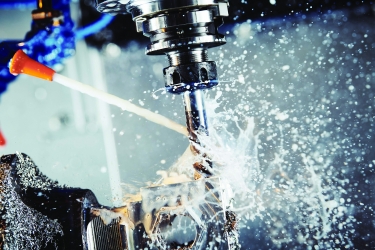Recent research has shown that top-performing machine shops annually invest two to three times more money in capital equipment than other shops. Not coincidentally, profit margins for high performers are almost double those reported by typical shops.
For all businesses, the objective is to achieve the largest possible profit margins. One way for metalworking operations to attain that goal is to appropriately invest in capital equipment—an expenditure that should not be limited to production equipment.
The Cost of Doing Business
Factors beyond an operation’s control are often among the most detrimental to a healthy bottom line. Two of the biggest market realities that shops are dealing with in 2019 are unavoidable and cannot be ignored.

When factoring in the ever-increasing price of cutting oil concentrate and the rising costs of spent fluid disposal, the goal of any metalworking fluids management initiative should be to increase the life of fluids. Images courtesy of PRAB
Tariffs. In March 2018, the U.S. imposed a 25 percent tariff on steel imports and a 10 percent tariff on aluminum imports, with few exceptions. President Donald Trump defended the tariffs, saying they were necessary to protect domestic steel production facilities and reduce U.S. reliance on imported metal. Despite promises of long-term benefits, many metalworking companies have felt short-term pain and been concerned that the tariffs would sharply increase prices for steel and aluminum, stop a number of planned projects and push orders away from U.S. manufacturers.
Coolants and fluids. It’s easy for people in the machining industry to consider coolants, cutting oils and other metalworking fluids a necessary evil. Many decision-makers, from those at small job shops to huge supply plants with global customer bases, tend to think of coolant only when there is a problem with it at a facility.
From a standpoint of dollars and cents, industry estimates indicate that metalworking fluids represent as much as 10 percent of the cost of a finished part. This includes the initial cost of the concentrate, maintenance, filtration and disposal. For comparison, cutting tools make up only about 6 percent of the cost—at most—of a finished part. When factoring in the ever-increasing price of cutting oil concentrate and the rising costs of spent fluid disposal, the goal of any metalworking fluids management initiative should be to increase fluid life.
Fortunately, many solutions for scrap metal processing and fluid recycling are available to help companies respond to these two factors and improve profit margins.
A Systematic Approach
Scrap metal recycling begins with volume reduction. Chip processing systems offer the dual benefit of reducing small to medium volumes of turnings and bushy wads to flowing metal chips while also separating chips from cutting fluid. This positions a manufacturer to increase the value of its machining scrap and reuse its fluid.
Typical scrap removal systems include a crusher and wringer or shredder and wringer, which processes loose metal turnings to deliver dry, flowing shovel-grade chips and reclaim up to 99 percent of metalworking fluids. Wringers and centrifuges provide another method of chip and fluid separation by using more than 600 G of centrifugal force to create dry chips and reclaim up to 99 percent of cutting fluid.
Compacting these dry, loose chips into smaller, denser briquettes is one way an operation can dramatically increase the value of its metal scrap. Briquetting machines compress metal chips, loose turnings and swarf into nearly solid, dry briquettes for feeding to a furnace, as these scrap pucks are easy to remelt, transport or store for enabling more floor space and a cleaner shop. Because of their condensed volume, briquettes fill containers better and bring higher value from recyclers than loose chips. Briquetting systems that use two opposing hydraulic cylinders are able to press metal equally from both sides to create the driest, most compact scrap pucks possible.
After the cutting oils are separated from the scrap, the right fluid management program can help to significantly decrease coolant costs. A variety of equipment and system options may reduce costs associated with the mixing of fluids used for cooling, lubricating and removing fines and chips from cutting zones, as well as fluids used for corrosion protection.
Remove and Save
Centralized coolant recycling systems remove tramp oils and suspended solids from contaminated coolant, control bacteria and can adjust fluid concentration for fluid recovery. Adding a centralized system benefits the bottom line by reducing fluid costs by up to 75 percent and reducing hazardous waste disposal costs by up to 90 percent. Utilizing a coolant manager in conjunction with a centralized recycling system prevents coolant rancidity by injecting ozone. These recycling systems extend tool life and could help a shop reduce tool purchases by up to 25 percent.
Magnetic separators also prolong tool life and are well suited to processes in which ferrous contaminants mix with water-based coolants or straight cutting oils. Separators employ high-intensity ferrite or rare earth magnets in a fully energized, rotating drum to continuously remove ferrous particles from the flow of liquid, which can reduce machine downtime by up to 50 percent—a major contributor to a healthy profit margin. These systems are often used as a pre-filter to limit contaminants reaching subsequent filtration equipment.

Turning and chip processing systems position an operation to increase the value of its machining scrap. Image courtesy of PRAB
Paper bed filters can extend cutting tool life by an average of 27 percent, improve surface finish and prolong coolant life by removing solids and other materials from all free-flowing industrial process liquids. Standard paper bed filtration systems are available with flow rates up to 130 gpm and different classes of filter fabric. This allows adjustments in micron-level clarity to achieve optimal removal of ferrous and nonferrous metals, as well as organic and inorganic contaminants, such as dirt, glass, rubber and plastic.
When the budget at a metalworking operation is tight, often because of factors beyond its control, financial decisions about purchasing capital equipment tend to favor front-line systems, such as CNC machines, mills, lathes and bandsaws. However, systems that handle the back end of the process—byproducts like scrap metal and spent fluid—can be equally important to improving a shop’s profit margin.
Implementing these systems could save money, generate revenue and increase the value of a business as a whole. In many cases, prioritizing these kinds of systems requires a reversal of conventional wisdom. Doing so may be difficult, but it is ultimately worthwhile when considering the fast return on investment and the increased value and efficiency that scrap handling and fluid recycling equipment can bring.
Contact Details
Related Glossary Terms
- computer numerical control ( CNC)
computer numerical control ( CNC)
Microprocessor-based controller dedicated to a machine tool that permits the creation or modification of parts. Programmed numerical control activates the machine’s servos and spindle drives and controls the various machining operations. See DNC, direct numerical control; NC, numerical control.
- coolant
coolant
Fluid that reduces temperature buildup at the tool/workpiece interface during machining. Normally takes the form of a liquid such as soluble or chemical mixtures (semisynthetic, synthetic) but can be pressurized air or other gas. Because of water’s ability to absorb great quantities of heat, it is widely used as a coolant and vehicle for various cutting compounds, with the water-to-compound ratio varying with the machining task. See cutting fluid; semisynthetic cutting fluid; soluble-oil cutting fluid; synthetic cutting fluid.
- cutting fluid
cutting fluid
Liquid used to improve workpiece machinability, enhance tool life, flush out chips and machining debris, and cool the workpiece and tool. Three basic types are: straight oils; soluble oils, which emulsify in water; and synthetic fluids, which are water-based chemical solutions having no oil. See coolant; semisynthetic cutting fluid; soluble-oil cutting fluid; synthetic cutting fluid.
- ferrite
ferrite
Solid solution of one or more elements in body-centered cubic iron. Unless otherwise designated, for instance, as chromium ferrite, the solute is generally assumed to be carbon. On an equilibrium diagram, there are two ferrite regions separated by an austenite area. The lower area is alpha ferrite and the upper area is delta ferrite. If there is no designation, alpha ferrite is assumed. Not more than 0.04 percent carbon can be dissolved in alpha iron. Ferrite is stable below 1,670º F (910º C); it is soft, highly ductile, and magnetic. Ferrite loses its magnetic property above 1,414º F (768º C).
- metalworking
metalworking
Any manufacturing process in which metal is processed or machined such that the workpiece is given a new shape. Broadly defined, the term includes processes such as design and layout, heat-treating, material handling and inspection.
- rancidity
rancidity
Bacterial and fungal growths in water-miscible fluids that cause unpleasant odors, stained workpieces and diminished fluid life.
- recovery
recovery
Reduction or removal of workhardening effects, without motion of large-angle grain boundaries.
- swarf
swarf
Metal fines and grinding wheel particles generated during grinding.
- turning
turning
Workpiece is held in a chuck, mounted on a face plate or secured between centers and rotated while a cutting tool, normally a single-point tool, is fed into it along its periphery or across its end or face. Takes the form of straight turning (cutting along the periphery of the workpiece); taper turning (creating a taper); step turning (turning different-size diameters on the same work); chamfering (beveling an edge or shoulder); facing (cutting on an end); turning threads (usually external but can be internal); roughing (high-volume metal removal); and finishing (final light cuts). Performed on lathes, turning centers, chucking machines, automatic screw machines and similar machines.









